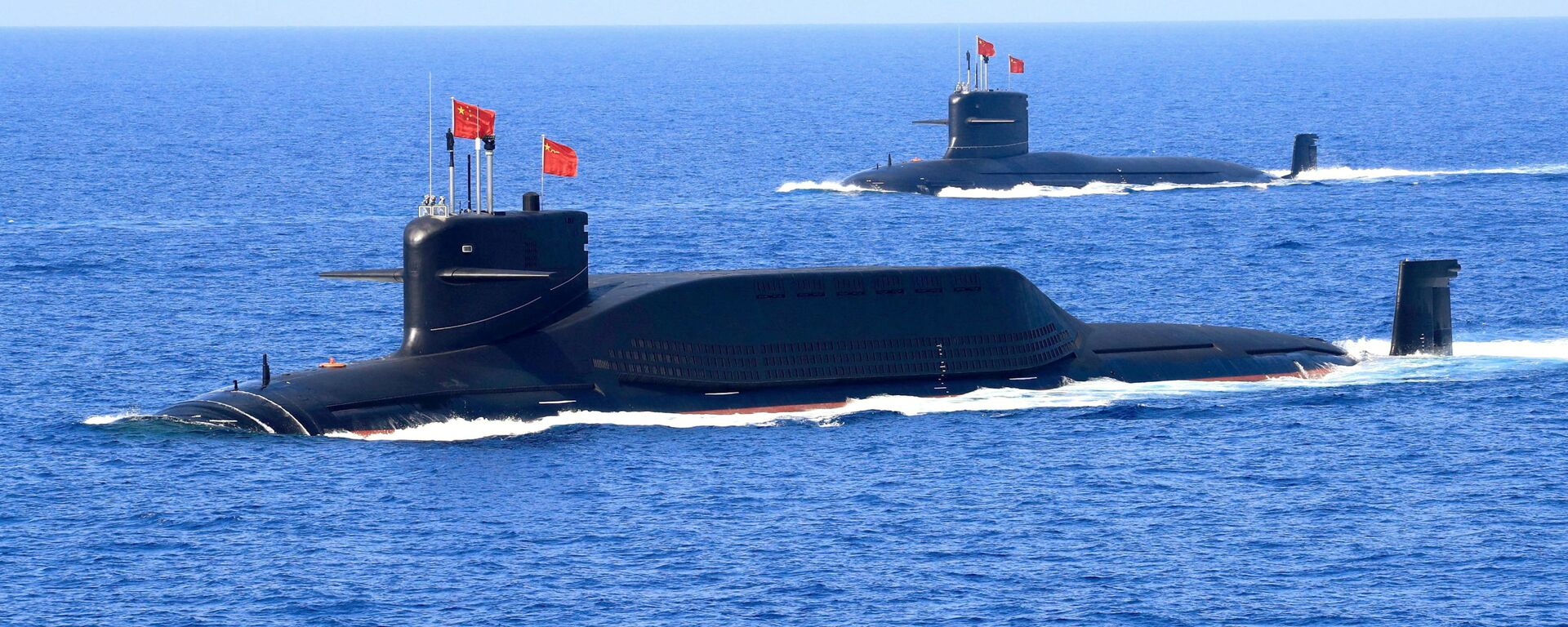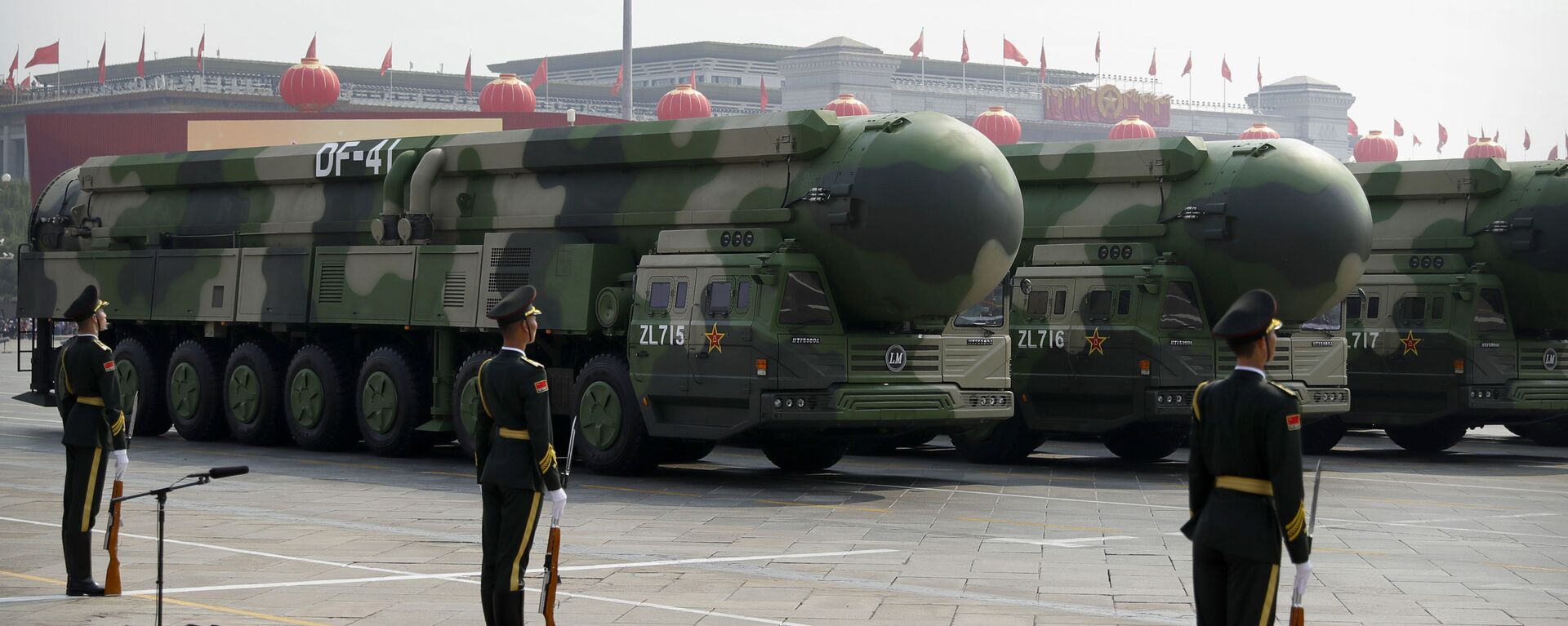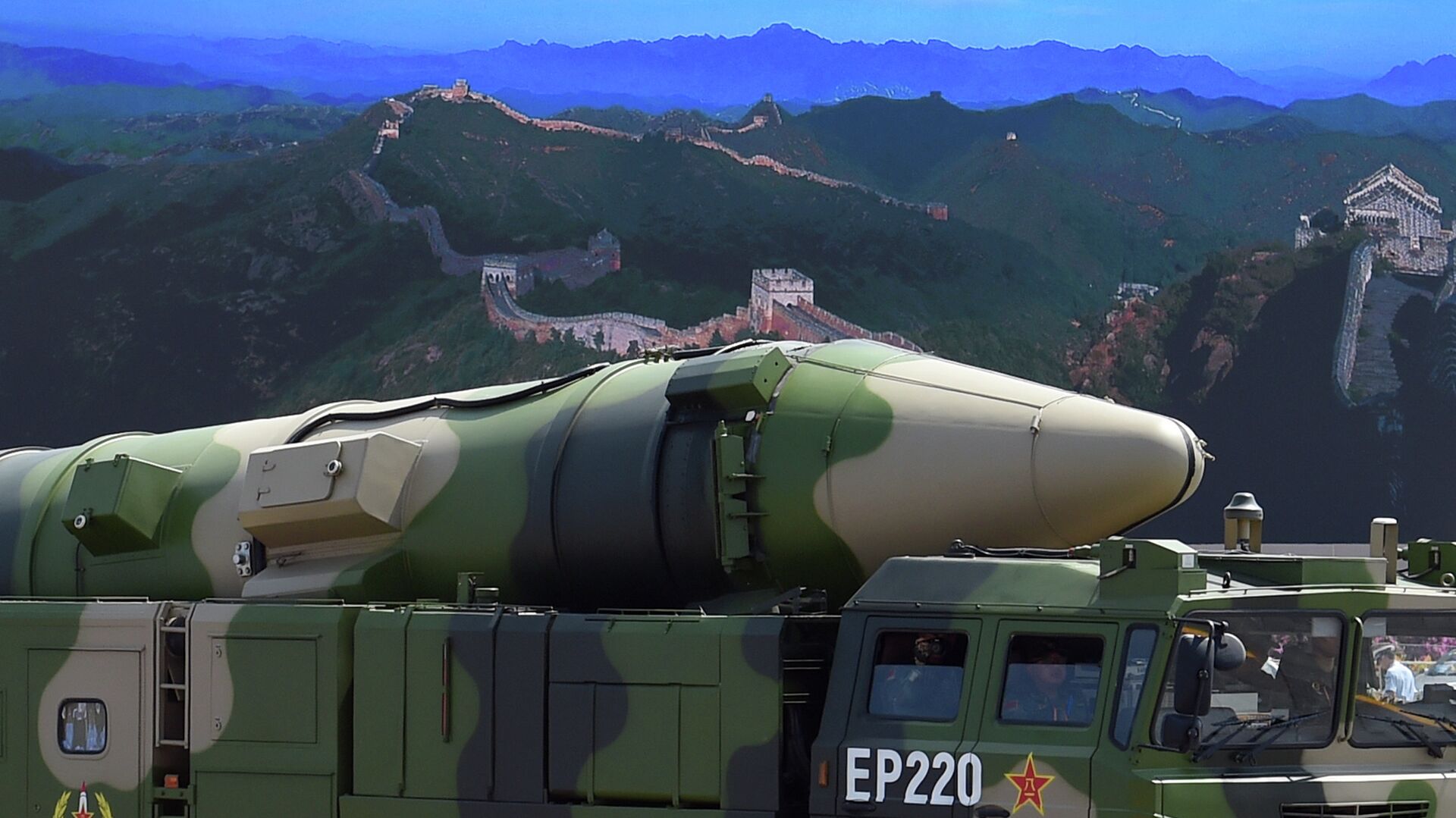https://sputnikglobe.com/20211116/mark-milley-calls-chinas-alleged-nuclear-buildup-one-of-largest-shifts-in-geostrategic-power-ever-1090780011.html
Mark Milley Calls China’s Alleged Nuclear Buildup ‘One of Largest Shifts in Geostrategic Power Ever’
Mark Milley Calls China’s Alleged Nuclear Buildup ‘One of Largest Shifts in Geostrategic Power Ever’
Sputnik International
China is estimated to possess between 350 and 400 nuclear warheads, and maintains that these weapons are meant to provide a “minimum deterrent posture,” i.e... 16.11.2021, Sputnik International
2021-11-16T15:58+0000
2021-11-16T15:58+0000
2022-01-04T09:58+0000
america
china
nuclear
https://cdn1.img.sputnikglobe.com/img/102698/04/1026980443_0:112:2501:1518_1920x0_80_0_0_bd5da887041c437b427d42db61aec065.jpg
Senior Pentagon officials led by Mark Milley are sounding the alarm about China’s alleged nuclear buildup, with America’s top general characterizing the developments as a historic shift in power.“This shift is occurring alongside a fundamental change in the character of war. We need to act with urgency to develop capabilities across all domains – land, sea, air, space, cyber and our strategic nuclear forces – to address this evolving global landscape. We have to act now. Otherwise, we risk condemning future generations to failure,” Milley said, speaking to FT in an interview published Monday.In early November, the Pentagon issued a report accusing China of planning to grow its nuclear arsenal to over 1,000 warheads by 2030, with Milley calling the country the “number one” state military challenger to US hegemony. For comparison, the US already has about 3,750 nuclear weapons in its arsenal, and is also planning to increase its warhead count.The Pentagon report also suggested that China has a “nascent nuclear triad” – meaning the means to deliver nuclear weapons from ground-launched silos, aircraft and missile submarines.Pentagon officials have expressed trepidation over China’s creation of new means to deliver its nukes, including maneuverable hypersonic glide vehicles capable of evading US missile defences, and a new class of intercontinental ballistic missile with ‘multiple independently targetable reentry vehicle’, or MIRV, capability.Beijing slammed the Pentagon report, with the Chinese Foreign Ministry saying the document was “full of prejudice” and that it “ignores facts” pertaining to China’s military strength. Washington, the ministry suggested, was looking to use the report to “hype up talk of the China nuclear threat,” and said that the US itself was the “world’s largest source of nuclear threat.”Beyond ‘Breathtaking’Earlier this year, US Strategic Command Chief Adm. Charles Richard – the commander of the US nuclear force, suggested that the word “breathtaking” may “not be enough” to describe the scale and speed of China’s nuclear expansion.Joint Chiefs Vice-Chief Gen. John Hyten, meanwhile, warned late last month that “all the hypersonic weapons [and] nuclear weapons [China is] building are not meant for their own population. It is meant for the United States of America, and we have to assume that, and we have to plan for that.”Hyten did not elaborate on how nuclear weapons could be “meant for” one’s “own population.”New Nuclear Doctrine?Last year, Pentagon officials complained about suspected plans to alter China’s nuclear doctrine to allow for a ‘launch on-warning’, which would give the People’s Liberation Army’s Rocket Force the right to launch nukes if incoming missiles were detected. The country’s existing nuclear doctrine calls for counterstrikes to start only after an incoming enemy missile hit its target – a geopolitically honorable but dangerous policy opening the door to Pentagon planning for a first strike aimed at wiping out China’s nuclear deterrent before the PRC is able to respond.The US and other nuclear powers do not have a ‘no-first use’ policy in place, with Nuclear Posture Review guidelines allowing Washington to launch nukes even at conventional adversaries, and calling for the creation of new classes of micro-nukes for this purpose.Commenting on Milley’s remarks, the Chinese Embassy in Washington told FT that the US has no grounds to complain about Beijing’s nuclear modernization efforts after spending hundreds of billions of dollars in this area itself. “The world will decide who is doing nuclear madness,” the Embassy stressed.In late September, Sha Zukang, China’s former ambassador to the UN, suggested that Beijing must be prepared to scrap its no first use policy to respond to new US alliances in the Indo-Pacific, and to the buildup of American forces “in our neighbourhood.”China declared a no first use policy in 1968, four years after it successfully tested its first atomic bomb in 1964.The People’s Republic has not publicly revealed how much it has spent on its nuclear modernization drive, with SIPRI estimating that Beijing committed a total of $252 billion to defence in 2020. For comparison, the United States, China’s top potential adversary, spent over $778 billion on the military during the same period, and kicked off a 30-year, $1.7 trillion spending spree in the mid-2010s to upgrade its nuclear deterrent.Despite dramatically outspending both China and Russia, US officials have repeatedly complained about America’s alleged lack of advanced nuclear weapons delivery capabilities. Last month, the Congressional Research Service announced that while Russia and China have already “likely fielded operational hypersonic glide vehicles – potentially armed with nuclear weapons,” US programmes are nowhere near operational status.
https://sputnikglobe.com/20211030/us-allies-reportedly-urge-biden-not-to-drop-possibility-of-preemptive-nuke-strike-on-russia-china-1090341199.html
https://sputnikglobe.com/20211104/beijing-blasts-pentagons-report-on-chinas-nuclear-arsenal-as-full-of-prejudice-1090468033.html
https://sputnikglobe.com/20210924/chinese-diplomat-explains-why-beijing-should-scrap-no-first-use-of-nukes-policy-1089373236.html
china
Sputnik International
feedback@sputniknews.com
+74956456601
MIA „Rossiya Segodnya“
2021
News
en_EN
Sputnik International
feedback@sputniknews.com
+74956456601
MIA „Rossiya Segodnya“
Sputnik International
feedback@sputniknews.com
+74956456601
MIA „Rossiya Segodnya“
america, china, nuclear
Mark Milley Calls China’s Alleged Nuclear Buildup ‘One of Largest Shifts in Geostrategic Power Ever’
15:58 GMT 16.11.2021 (Updated: 09:58 GMT 04.01.2022) China is estimated to possess between 350 and 400 nuclear warheads, and maintains that these weapons are meant to provide a “minimum deterrent posture,” i.e. enough nukes to respond to aggression by a strategic adversary. The People’s Republic is the only nuclear weapons-armed state in the world with ‘no first use’ restrictions on its weapons.
Senior Pentagon officials led by Mark Milley are sounding the alarm about China’s alleged nuclear buildup, with America’s top general characterizing the developments as a historic shift in power.
“We’re witnessing one of the largest shifts in geostrategic power that the world has ever experienced,” the joint chiefs chairman said, describing PRC’s efforts as something akin to a “Sputnik moment,” –a reference to the 1957 launch of an artificial satellite by the Soviet Union which caught the United States off guard and sparked a space race.
“This shift is occurring alongside a fundamental change in the character of war. We need to act with urgency to develop capabilities across all domains – land, sea, air, space, cyber and our strategic nuclear forces – to address this evolving global landscape. We have to act now. Otherwise, we risk condemning future generations to failure,” Milley
said, speaking to FT in an interview published Monday.
The four-star general did not elaborate on what more Washington, which is already in the middle of a thirty-year, $1.7 trillion spending spree to upgrade its nuclear arsenal, could do to try to check China.

30 October 2021, 10:39 GMT
In early November, the Pentagon issued a
report accusing China of planning to grow its nuclear arsenal to over 1,000 warheads by 2030, with Milley calling the country the “number one” state military challenger to US hegemony. For comparison, the US already has about 3,750 nuclear weapons in its arsenal, and is also planning to increase its warhead count.
The Pentagon report also suggested that China has a “nascent nuclear triad” – meaning the means to deliver nuclear weapons from ground-launched silos, aircraft and missile submarines.
Pentagon officials have expressed trepidation over China’s creation of new means to deliver its nukes, including maneuverable hypersonic glide vehicles capable of evading US missile defences, and a new class of intercontinental ballistic missile with ‘multiple independently targetable reentry vehicle’, or MIRV, capability.
Beijing slammed the Pentagon report, with the Chinese Foreign Ministry saying the document was “full of prejudice” and that it “ignores facts” pertaining to China’s military strength. Washington, the ministry suggested, was looking to use the report to “hype up talk of the China nuclear threat,” and said that the US itself was the “world’s largest source of nuclear threat.”

4 November 2021, 08:12 GMT
Earlier this year, US Strategic Command Chief Adm. Charles Richard – the commander of the US nuclear force, suggested that the word “breathtaking” may “not be enough” to describe the scale and speed of China’s nuclear expansion.
Joint Chiefs Vice-Chief Gen. John Hyten, meanwhile,
warned late last month that “all the hypersonic weapons [and] nuclear weapons [China is] building are not meant for their own population. It is meant for the United States of America, and we have to assume that, and we have to plan for that.”
Hyten did not elaborate on how nuclear weapons could be “meant for” one’s “own population.”
Last year, Pentagon officials
complained about suspected plans to alter China’s nuclear doctrine to allow for a ‘launch on-warning’, which would give the People’s Liberation Army’s Rocket Force the right to launch nukes if incoming missiles were detected. The country’s existing nuclear doctrine calls for counterstrikes to start only after an incoming enemy missile hit its target – a geopolitically honorable but dangerous policy opening the door to Pentagon planning for a first strike aimed at wiping out China’s nuclear deterrent before the PRC is able to respond.
The US and other nuclear powers do not have a ‘no-first use’ policy in place, with Nuclear Posture Review guidelines allowing Washington to launch nukes even at conventional adversaries, and calling for the creation of new classes of micro-nukes for this purpose.
Commenting on Milley’s remarks, the Chinese Embassy in Washington told FT that the US has no grounds to complain about Beijing’s nuclear modernization efforts after spending hundreds of billions of dollars in this area itself. “The world will decide who is doing nuclear madness,” the Embassy stressed.
In late September, Sha Zukang, China’s former ambassador to the UN, suggested that Beijing must be prepared to scrap its no first use policy to respond to new US alliances in the Indo-Pacific, and to the buildup of American forces “in our neighbourhood.”

24 September 2021, 15:07 GMT
China declared a no first use policy in 1968, four years after it successfully tested its first atomic bomb in 1964.
The People’s Republic has not publicly revealed how much it has spent on its nuclear modernization drive, with SIPRI estimating that Beijing committed a total of $252 billion to defence in 2020. For comparison, the United States, China’s top potential adversary, spent over $778 billion on the military during the same period, and kicked off a 30-year, $1.7 trillion spending spree in the mid-2010s to upgrade its nuclear deterrent.
Despite dramatically outspending both China and Russia, US officials have repeatedly complained about America’s alleged lack of advanced nuclear weapons delivery capabilities. Last month, the Congressional Research Service announced that while Russia and China have already “likely fielded operational hypersonic glide vehicles – potentially armed with nuclear weapons,” US programmes are nowhere near operational status.




